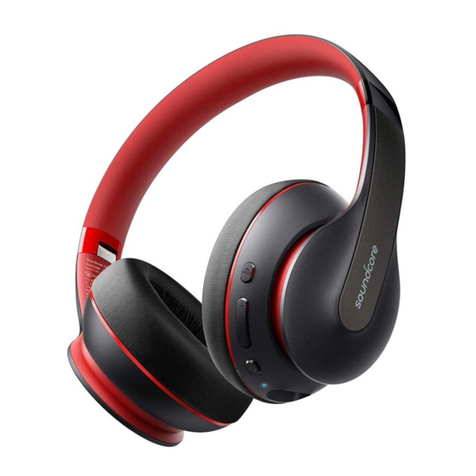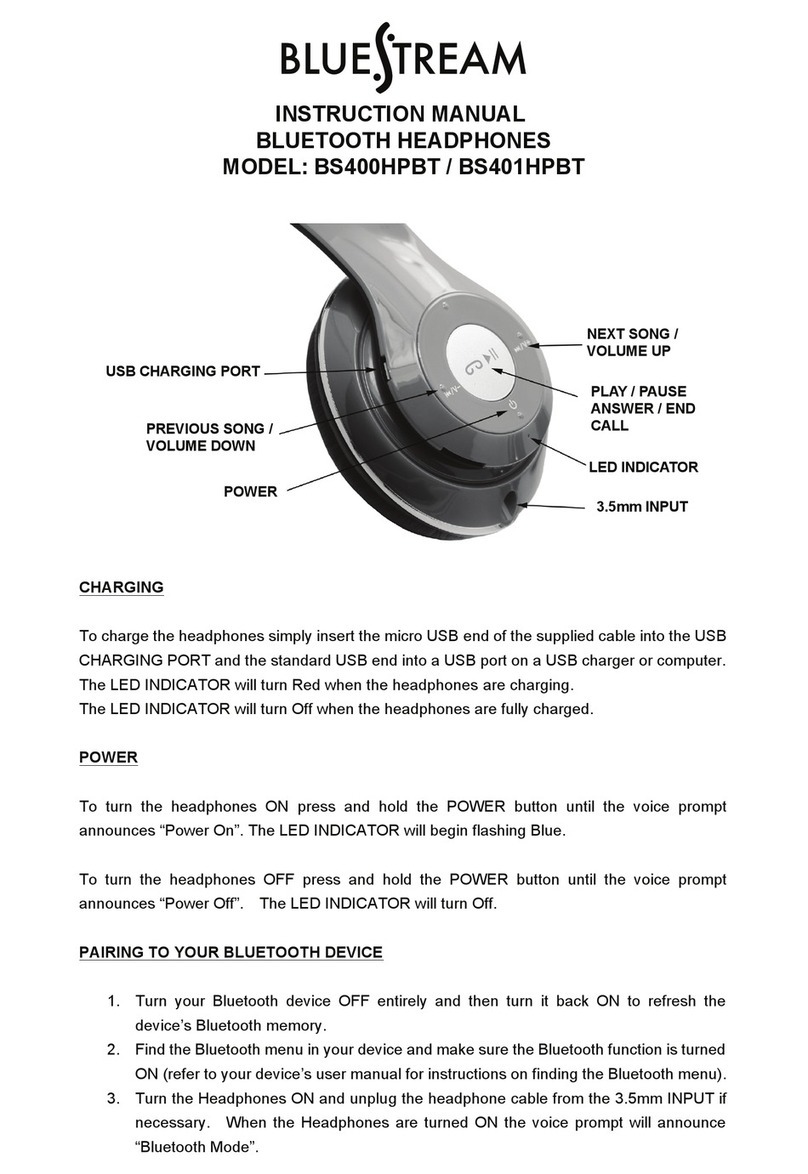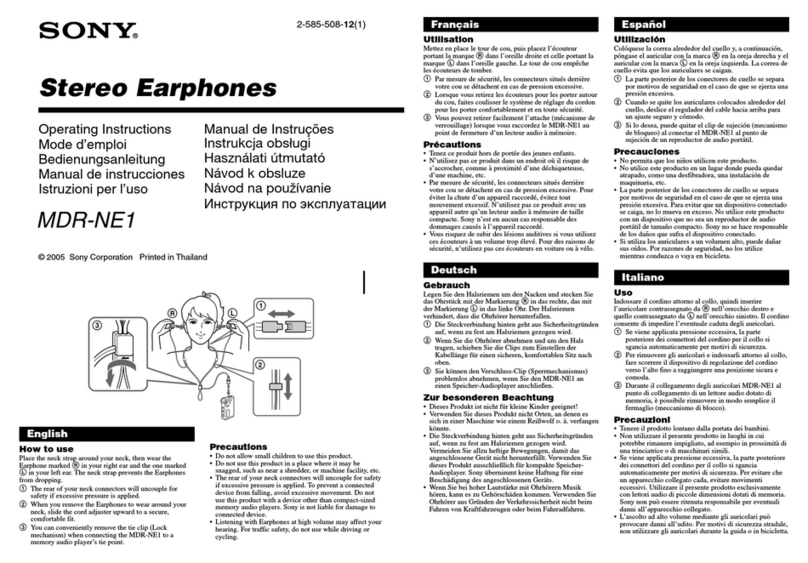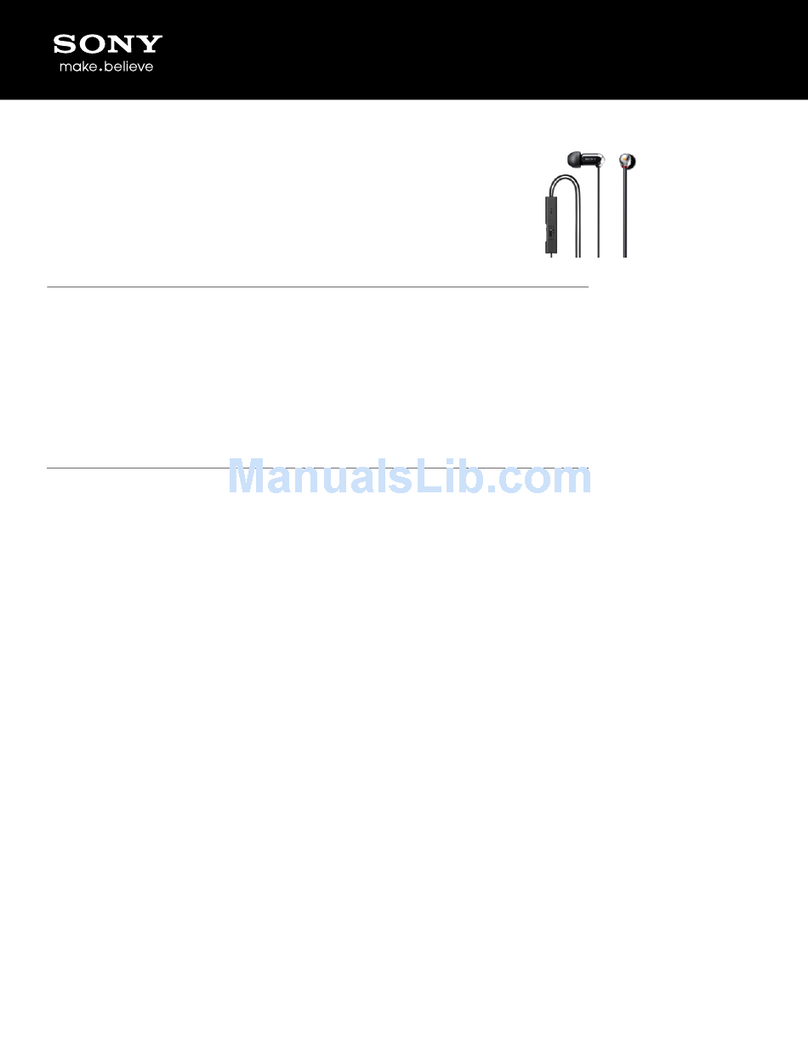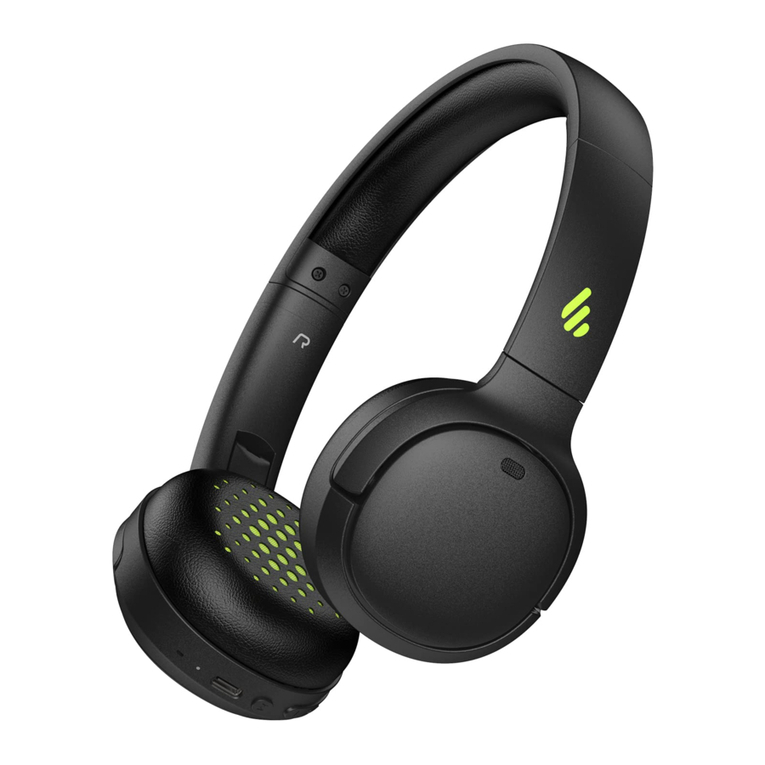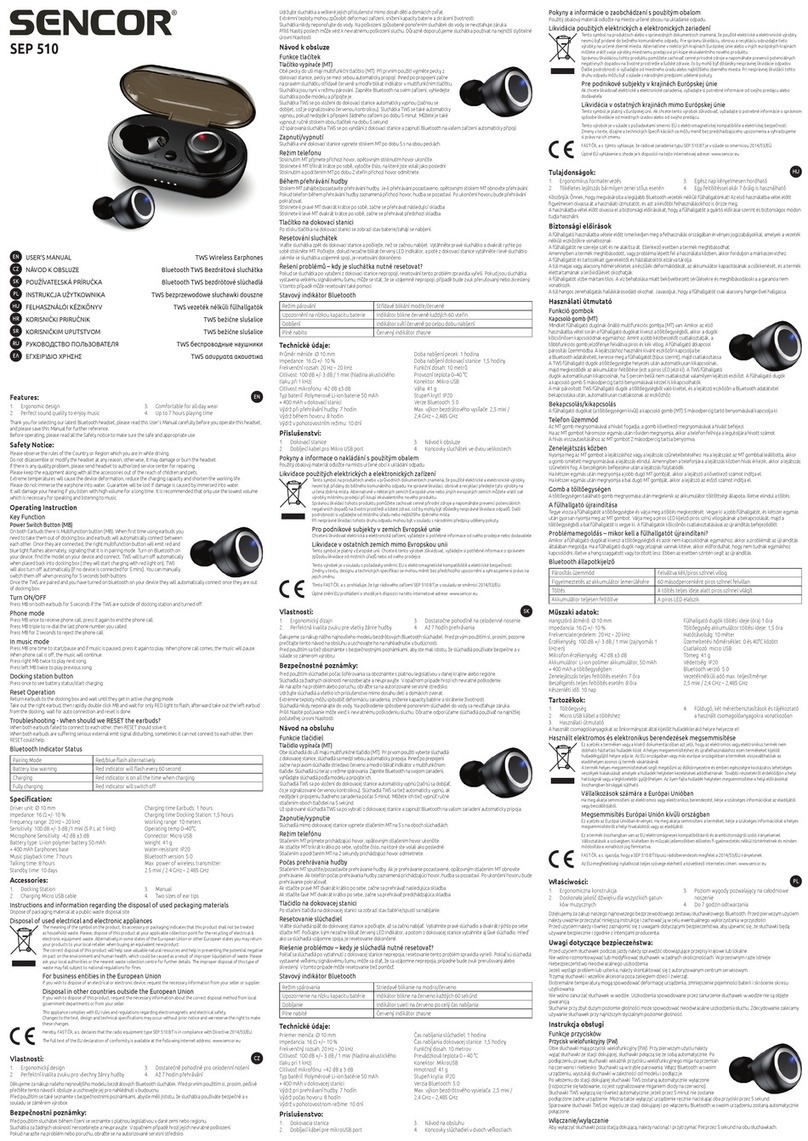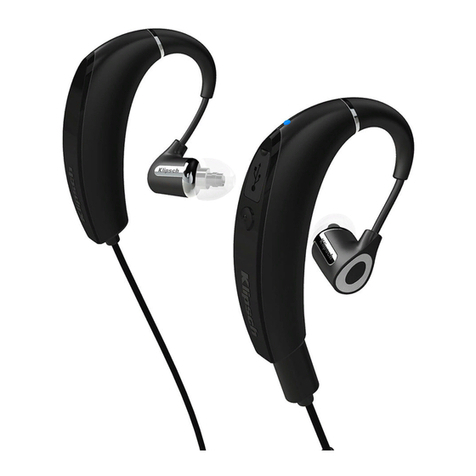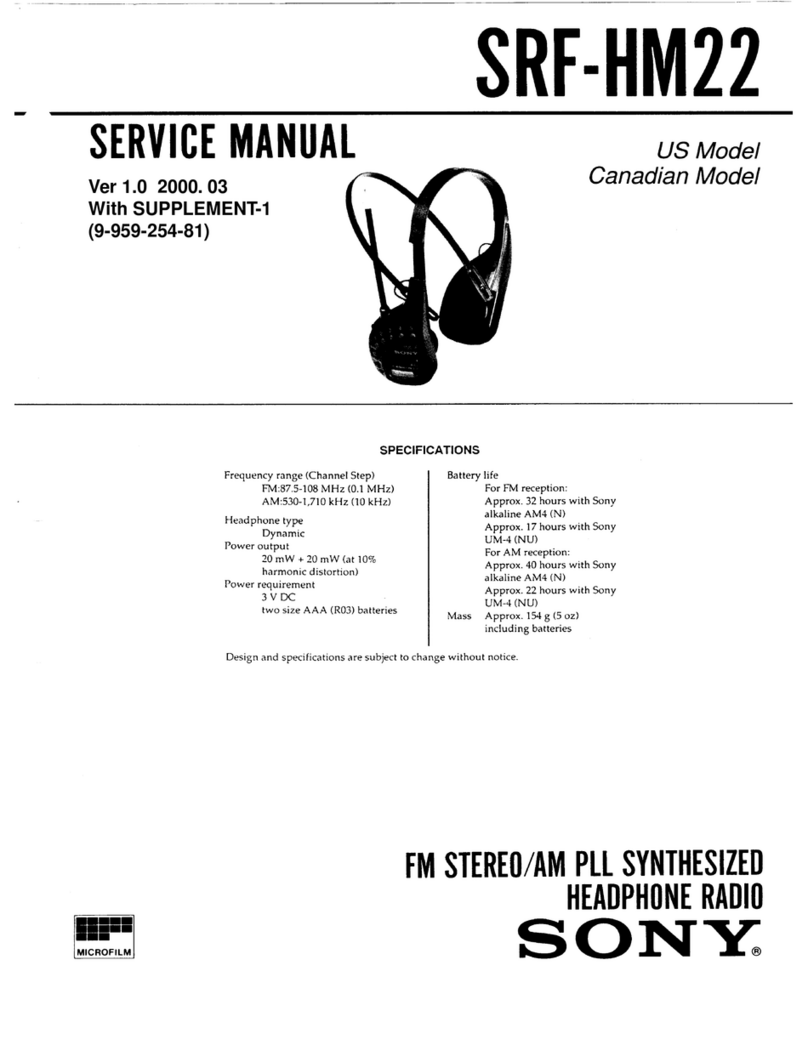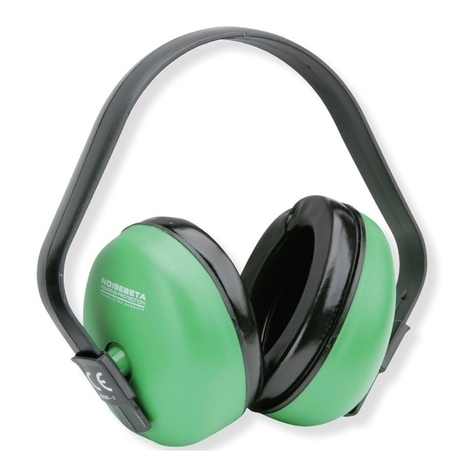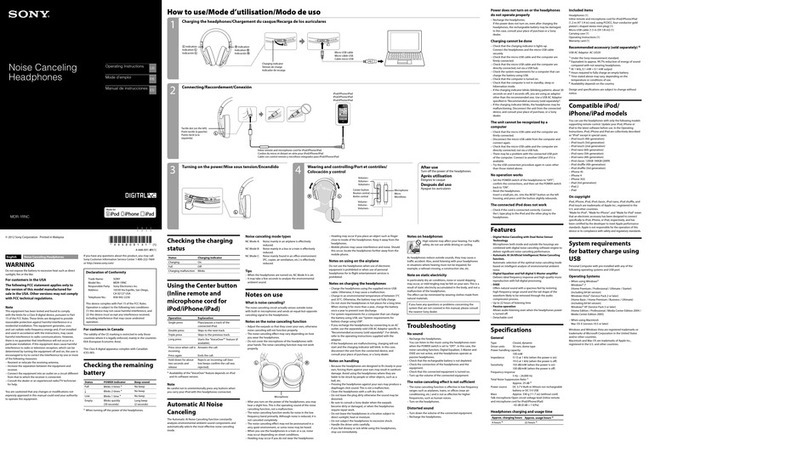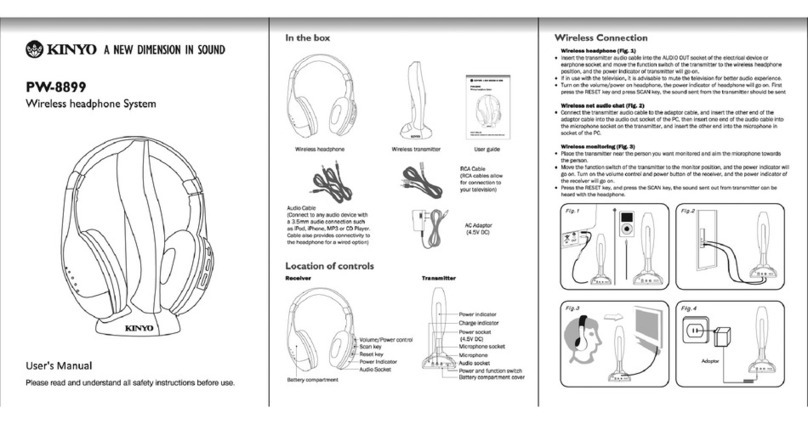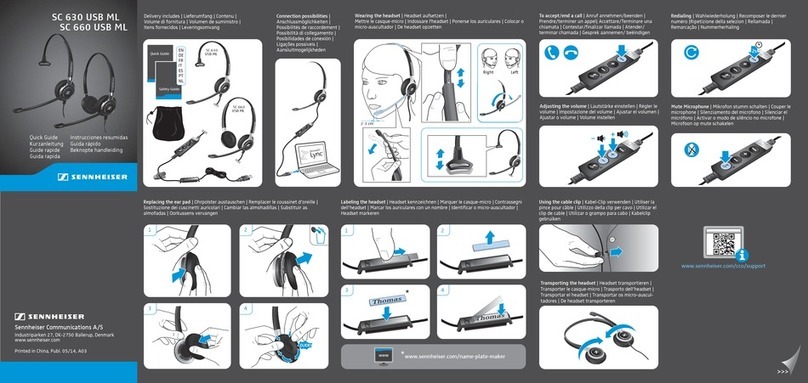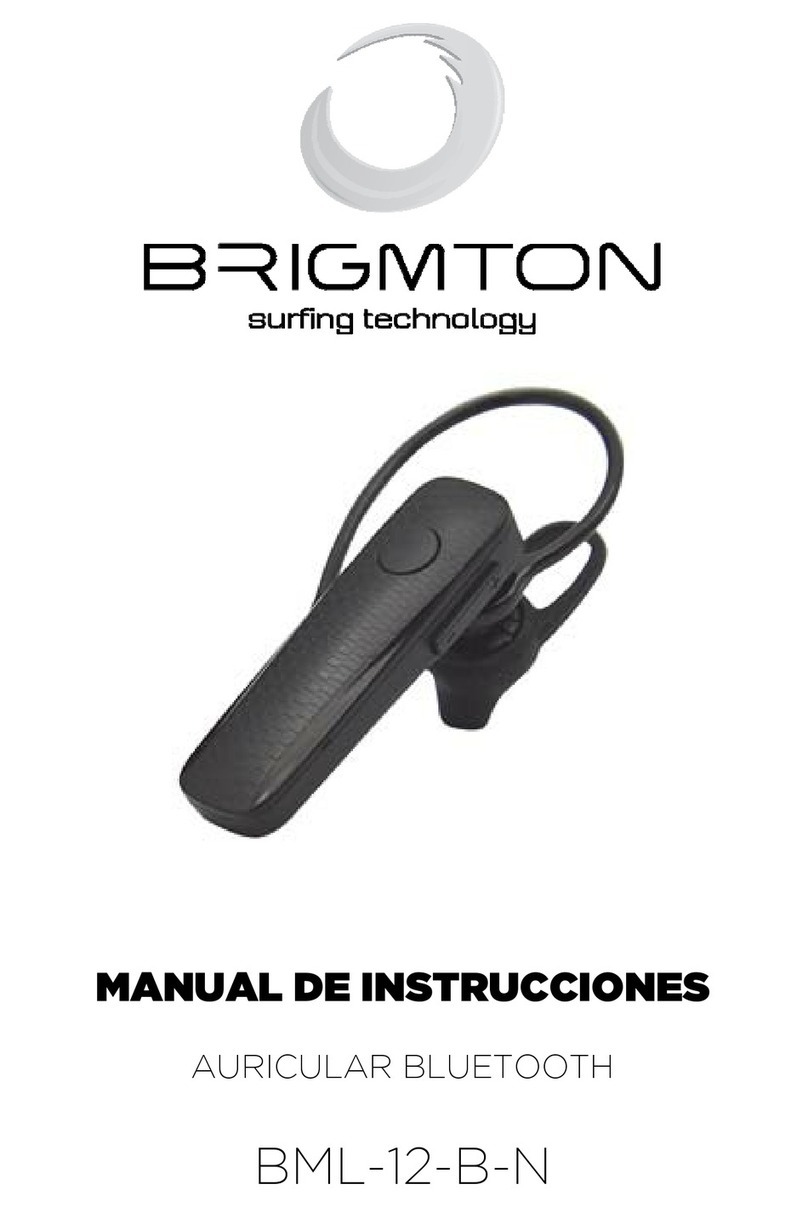Optimus Wireless Stereo Headphone System User manual

Cat. No. 33-1143
OWNER’S MANUAL
Please read before using this equipment.
Wireless Stereo
Headphone S
y
stem
33-1143.fm Page 1 Tuesday, August 10, 1999 10:09 AM

2
INTRODUCTION
Your Optimus Wireless Stereo Head-
phone System uses an infrared light
transmitter to send signals from an au-
dio source (such as a TV or radio) to
special headphones equipped with a
built-in receiver. This frees you from
the tangle of headphone wire running
between your audio source and the
headphones.
You can use the system in your home
or office, up to 20 feet from the audio
source, and you can set the sound
level on each earpiece individually.
A special feature of this system is that,
unlike many other cordless head-
phones, it provides full stereo sound.
The system also allows you to re-
charge the batteries without a battery
charger.
The system includes a transmitter, a
stereo headphone receiver, two re-
chargeable AAA nickel-cadmium bat-
teries, a Y-type phono plug adapter,
and an AC adapter.
© 1997 Tandy Corporation.
All Rights Reserved.
Optimus is a registered trademark used by Tandy Corporation.
RadioShack is a trademark used by Tandy Corporation.
33-1143.fm Page 2 Tuesday, August 10, 1999 10:09 AM

3
THE FCC WANTS YOU
TO KNOW
Your headphone system might cause
TV or radio interference even when it
is operating properly. To determine
whether your headphone system is
causing the interference, turn off your
headphone system. If the interference
goes away, your headphone system is
causing the interference. Try to elimi-
nate the interference by:
• Moving your headphone system
away from the receiver.
• Connecting your headphone sys-
tem to an outlet that is on a differ-
ent electrical circuit from the
receiver.
• Contacting your local RadioShack
store for help.
If you cannot eliminate the interfer-
ence, the FCC requires that you stop
using your headphone system.
This symbol is intended to alert you
to the presence of uninsulated dan-
gerous voltage within the product’s
enclosure that might be of sufficient
magnitude to constitute a risk of
electric shock. Do not open the
product’s case.
This symbol is intended to inform
you that important operating and
maintenance instructions are in-
cluded in the literature accompany-
ing this product.
RISK OF ELECTRIC SHOCK.
DO NOT OPEN.
CAUTION: TO REDUCE THE RISK OF
ELECTRIC SHOCK, DO NOT REMOVE
COVER OR BACK. NO USER-SERVICE-
ABLE PARTS INSIDE. REFER SERVIC-
ING TO QUALIFIED PERSONNEL.
Warning: To reduce the risk of fire
or shock hazard, do not expose
this product to rain or moisture.
CAUTION
!
!
33-1143.fm Page 3 Tuesday, August 10, 1999 10:09 AM

4
PREPARATION
Before you can use your headphone
system, you must find a suitable loca-
tion for its transmitter, make the nec-
essary transmitter connections, then
install and charge the headphone bat-
teries.
PLACING THE
TRANSMITTER
The transmitter sends out an infrared
signal in a 30-degree, conical pattern.
Since infrared light rays travel in a
straight line, place the transmitter at
the same height or slightly higher than
the expected height of the headphone
receiver.
Notes:
• Since sunlight also contains infra-
red light, avoid placing the system
outdoors, near a window, or any
place where the light might pre-
vent optimum transmission.
• Do not point the transmitter
directly toward a window. The
infrared signals do not reflect well
and reception might be poor.
• Do not place any object between
the transmitter and the receiver
that might block the infrared trans-
mission.
CONNECTING THE
TRANSMITTER TO YOUR
AUDIO SOURCE
You can connect the transmitter to
your audio source’s stereo headphone
jack or to separate left and right audio
output jacks (if available). If you con-
nect to audio output jacks, you can
use the headphone system’s volume
control to adjust the volume without
turning up your audio source.
To connect the transmitter to your au-
dio source’s stereo headphone jack,
insert the transmitter’s built-in 1/8-inch
plug into the audio source’s 1/8-inch
stereo headphone jack.
Illust.
Illust.
33-1143.fm Page 4 Tuesday, August 10, 1999 10:09 AM

5
To connect the transmitter to your au-
dio source’s audio output jacks, insert
the transmitter’s built-in 1/8-inch plug
into the supplied Y-type phono plug
adapter, then connect the red plug to
the audio source’s right audio output
jack and connect the white plug to the
left audio output jack.
CONNECTING THE
TRANSMITTER TO
POWER
To power the transmitter, insert the
supplied AC adapter’s barrel plug into
the 19V 200mA jack on the back of the
transmitter. Then plug the adapter’s
other end into a standard AC outlet.
Cautions:
• Do not leave the adapter plugged
into the AC outlet when the barrel
plug is not plugged into the trans-
mitter.
• The supplied AC adapter supplies
19 volts and delivers at least 200
milliamps. Its center tip is set to
negative and its plug correctly fits
the transmitter’s 19V 200mA jack.
Using an adapter that does not
meet these specifications could
damage the transmitter or the
adapter.
INSTALLING THE
HEADPHONES’
BATTERIES
To power the headphone receiver, fol-
low these steps to install the two sup-
plied AAA nickel-cadmium batteries,
one in each earpiece.
1. Remove each battery compart-
ment cover by pushing in the tab
and pulling up the cover in the
direction of the arrow.
Illust.
showin
g
connection
of 1/8-inch
plu
g
to
Y-type
adapter
Illust.
Illust.
33-1143.fm Page 5 Tuesday, August 10, 1999 10:09 AM

6
2. Place one battery in each ear-
piece compartment, as indicated
by the polarity symbols (+ and –)
inside the compartment.
3. Replace the covers.
Notes:
• If you do not plan to use the head-
phones for a month or more,
remove and store the batteries.
• If the batteries will not hold a
charge, replace them. We recom-
mend RadioShack Cat. No. 23-
127.
Caution: Use only rechargeable
nickel-cadmium batteries. Do not use
non-rechargeable batteries.
Important: At the end of the batteries’
useful life, the rechargeable nickel-
cadmium batteries must be recycled
or disposed of properly. Contact your
local, county, or state hazardous
waste management authorities for in-
formation on recycling or disposal pro-
grams in your area. Some options that
might be available are: municipal
curbside collection, drop-off boxes at
retailers, recycling collection centers,
and mail-back programs.
CHARGING THE
HEADPHONES’
BATTERIES
You must charge the batteries at least
14 hours before you use the system
the first time or when you replace the
batteries.
Follow these steps to charge the bat-
teries.
1. Set the transmitter’s POWER
switch to OFF (CHARGE).
2. Set the headphone receiver’s ON/
OFF switch to OFF.
Illust.
Illust.
Illust.
33-1143.fm Page 6 Tuesday, August 10, 1999 10:09 AM

7
3. Insert the plug of the transmitter’s
headset charging cord into the
CHARGE jack on the left earpiece
of the headphone receiver. The
charging indicator behind the win-
dow on the front of the transmitter
lights.
Note: If the charging indicator
does not light or blinks continu-
ously when you set the ON/OFF
switch on the headphone receiver
to OFF and the POWER switch on
the transmitter to OFF (CHARGE),
be sure the charging cord and AC
adapter are correctly and securely
connected.
4. When you finish charging the
headphone batteries, be sure to
disconnect the charging cord.
Illust.
33-1143.fm Page 7 Tuesday, August 10, 1999 10:09 AM

8
OPERATION
LISTENING SAFELY
To protect your hearing, follow these
guidelines when you use headphones.
• Since a pop sounds each time you
turn the headphones on and off,
always turn on the headphone
receiver before putting the head-
phones on your head and always
remove the headphones from
your head before you turn them
off.
• Set the volume to the lowest set-
ting before you begin listening.
After you begin listening, adjust
the volume to a comfortable level.
• Do not listen at extremely high
volume levels. Extended high-
volume listening can lead to per-
manent hearing loss.
• Once you set the volume, do not
increase it. Over time, your ears
adapt to the volume level, so a
volume level that does not cause
discomfort might still damage your
hearing.
USING THE SYSTEM
1. Turn on your audio source and
adjust its volume control to the
minimum position.
2. Set the transmitter’s POWER
switch to ON.
Caution: The transmitter’s sur-
face heats slightly during opera-
tion. Do not touch the transmitter’s
surface while it is on.
3. Set the headphone receiver’s ON/
OFF switch to ON.
Illust.
Illust.
33-1143.fm Page 8 Tuesday, August 10, 1999 10:09 AM

9
4. Rotate VOL. on each earpiece to
the minimum position.
5. Put on the headphone receiver. If
necessary, adjust the headphone
receiver’s size by pulling down or
pushing up on each end.
6. If you connected the transmitter to
audio output jacks, adjust VOL. on
each earpiece to a comfortable lis-
tening level.
If you connected the transmitter to
a headphone jack, set the audio
source’s volume control to a level
that causes the audio input indica-
tor to flicker brightly. Then adjust
VOL. on each earpiece to a com-
fortable listening level.
Notes:
• If the audio source’s volume
level is too high, the audio input
indicator lights steadily and the
sound is distorted.
• If the audio source’s volume
level is not high enough, the
audio input indicator does not
light at all and the sound quality
might not be clear.
7. To turn off the system, remove the
headphones from your head, then
set ON/OFF on the headphone
receiver to OFF, and POWER on
the transmitter to OFF (CHARGE).
Note: Be sure to turn off the system
when you are not using it, so your
nickel-cadmium batteries will last as
long as possible.
Illust.
Illust.
33-1143.fm Page 9 Tuesday, August 10, 1999 10:09 AM

10
MAINTENANCE
Your Optimus Wireless Stereo Headphone System is an example of superior design
and craftsmanship. The following suggestions will help you care for your system so
you can enjoy it for years.
Keep the system dry. If it gets wet, wipe it dry immediately. Liquids
might contain minerals that can corrode the electronic circuits.
Use and store the system only in normal temperature environments.
Temperature extremes can shorten the life of electronic devices,
damage batteries, and distort or melt plastic parts.
Keep the system away from dust and dirt, which can cause prema-
ture wear of parts.
Handle the system gently and carefully. Dropping it can damage cir-
cuit boards and cases and can cause the system to work improperly.
Use only fresh batteries of the required size and type. Batteries can
leak chemicals that damage your system’s electronic parts.
Wipe the system with a damp cloth occasionally to keep it looking
new. Do not use harsh chemicals, cleaning solvents, or strong deter-
gents to clean the system.
Modifying or tampering with the system’s internal components can cause a malfunc-
tion and might invalidate your system’s warranty and void your FCC authorization to
operate it. If your system is not performing as it should, take it to your local Ra-
dioShack store for assistance.
33-1143.fm Page 10 Tuesday, August 10, 1999 10:09 AM

11
SPECIFICATIONS
Transmission Mode ...................................Infrared (900 nm) Frequency Modulation
Operation Voltage.......................................................Transmitter: 19 V AC Adapter
Headphone Receiver: Two AAA Ni-Cd Batteries
Frequency Response .............................................................................30–6000 Hz
Distortion ...........................................................................................................2.5%
S/N Ratio....................................................................40 dB (131/8Feet or 4 Meters)
Maximum Operation Distance......................................................20 Feet (6 Meters)
Dimensions (HWD).......................................... Transmitter: 811/16 × 47/8× 23/8Inches
(220 × 125 × 60 mm)
Headphone Receiver: 75/16 × 61/2× 215/16 Inches
(185 ×165 × 75 mm)
Weight .........................................................................................Transmitter: 8.1 oz
(229 g)
Headphone Receiver: 6.7 oz
(189 g)
Included Accessories..............................................................................AC Adapter,
Dual Y-Type Phono Plugs to 1/8-Inch Stereo Jack Audio Adapter
Specifications are typical; individual units might vary. Specifications are subject to
change and improvement without notice.
33-1143.fm Page 11 Tuesday, August 10, 1999 10:09 AM

RadioShack
A Division of Tandy Corporation
Fort Worth, Texas 76102
3A7 Printed in Hong Kong
Limited Ninety-Day Warranty
This product is warranted by RadioShack against manufacturing defects in material and workman-
ship under normal use for ninety (90) days from the date of purchase from RadioShack company-
owned stores and authorized RadioShack franchisees and dealers. In the event of a product defect
during the warranty period, take the product and the RadioShack sales receipt as proof of purchase
date to any RadioShack store. RadioShack will, at its option, unless otherwise provided by law:
(a) correct the defect by product repair without charge for parts and labor; (b) replace the product
with one of the same or similar design; or (c) refund the purchase price. All replaced parts and prod-
ucts, and products on which a refund is made, become the property of RadioShack. New or recondi-
tioned parts and products may be used in the performance of warranty service. Repaired or replaced
parts and products are warranted for the remainder of the original warranty period. You will be
charged for repair or replacement of the product made after the expiration of the warranty period.
This warranty does not cover: (a) damage or failure caused by or attributable to acts of God, abuse,
accident, misuse, improper or abnormal usage, failure to follow instructions, improper installation or
maintenance, alteration, lightning or other incidence of excess voltage or current; (b) any repairs
other than those provided by a RadioShack Authorized Service Facility; (c) consumables such as
fuses or batteries; (d) cosmetic damage; (e) transportation, shipping or insurance costs; or (f) costs
of product removal, installation, set-up service adjustment or reinstallation.
EXCEPT AS PROVIDED HEREIN, RadioShack MAKES NO EXPRESS WARRANTIES AND ANY
IMPLIED WARRANTIES, INCLUDING THOSE OF MERCHANTABILITY AND FITNESS FOR A
PARTICULAR PURPOSE, ARE LIMITED IN DURATION TO THE DURATION OF THE WRITTEN
LIMITED WARRANTIES CONTAINED HEREIN. EXCEPT AS PROVIDED HEREIN, RadioShack
SHALL HAVE NO LIABILITY OR RESPONSIBILITY TO CUSTOMER OR ANY OTHER PERSON
OR ENTITY WITH RESPECT TO ANY LIABILITY, LOSS OR DAMAGE CAUSED DIRECTLY OR
INDIRECTLY BY USE OR PERFORMANCE OF THE PRODUCT OR ARISING OUT OF ANY
BREACH OF THIS WARRANTY, INCLUDING, BUT NOT LIMITED TO, ANY DAMAGES RESULT-
ING FROM INCONVENIENCE, LOSS OF TIME, DATA, PROPERTY, REVENUE, OR PROFIT OR
ANY INDIRECT, SPECIAL, INCIDENTAL, OR CONSEQUENTIAL DAMAGES, EVEN IF Ra-
dioShack HAS BEEN ADVISED OF THE POSSIBILITY OF SUCH DAMAGES.
Some states do not allow the limitations on how long an implied warranty lasts or the exclusion of in-
cidental or consequential damages, so the above limitations or exclusions may not apply to you.
This warranty gives you specific legal rights, and you may also have other rights which vary from
state to state.
RadioShack Customer Relations, Dept. W, 100 Throckmorton St., Suite 600, Fort Worth, TX 76102
We Service What We Sell
1/97
33-1143.fm Page 12 Tuesday, August 10, 1999 10:09 AM
Table of contents
Other Optimus Headphones manuals


